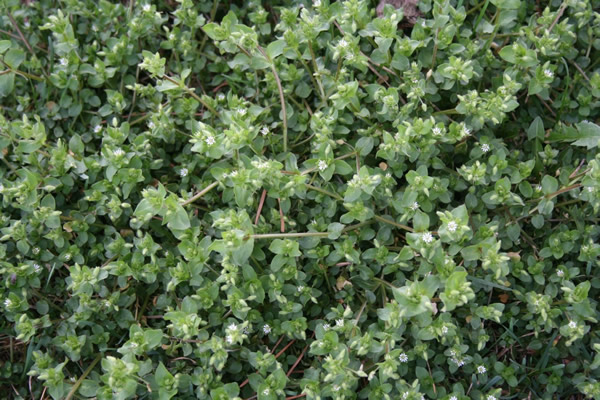Issue 13, October 9, 2019
Prepare for Chickweed Germination
Temperatures are finally cooling off and our cool season annual weeds are really starting to germinate. If you have not applied already, now is the time to get a preemergent herbicide down. Mulch also works well to prevent germination in landscape beds.
Common chickweed (Stellaria media) is a cool-season annual (also known as a winter annual) member of the Pink family (Caryophyllaceae) that reproduces by seeds. Normally, cool-season annuals germinate in the autumn, flower the following spring, and die soon after summer temperatures rise; common chickweed, however, may occasionally persist through summer in sites protected from heat and drought. Common chickweed occurs in cool, moist, shady, often compacted, fertile sites in spring and autumn.

Chickweed seedlings.
Common chickweed often forms large, dense patches in mowed areas but grows more upright in unmowed settings. The stems will often form mats over surrounding low growing plants. The stems are softly hairy and can root at the nodes when lying prostrate. The roots are shallow and fibrous. Leaves are bright green, opposite, simple, broadly oval, and usually less than 1 inch long. Its small, spring-borne white flowers are approximately 1/2 inch in diameter, have five petals, and are star shaped. The 5 petals are deeply lobed and appear from a distance as 10 petals.

Mature chickweed growing in spring.
To control common chickweed without chemicals, maintain turf density and health by employing proper turf culture and mechanically remove the weed from the site. For chemical control, apply postemergence herbicides (for example, products containing 2,4-D, MCPP, dicamba, clopyralid, triclopyr, carfentrazone, florasulam, or penoxsulam) in midspring or mid- to late autumn during active growth; apply preemergence herbicides (for example, products containing benefin + trifluralin, dithiopyr, isoxaben, pendimethalin, prodiamine, or pronamide) before germination in late summer or early autumn. These lists are provided for reference and are not all-inclusive. Please carefully read and follow all label directions. Hand removal can also be used at this plant pulls easily.
A closely related plant is mouseear chickweed (Cerastium vulagtum). This weed has a similar growth habit, however it is a perennial which commonly roots at the nodes. The leaves are densely hairy and typically quite oblong. It occurs less commonly in a general turfgrass or landscape setting.
Adapted from past HYG articles by Tom Voigt, Bruce Spangenberg, Luke Cella, and Michelle Wiesbrook.
Author:
Michelle Wiesbrook